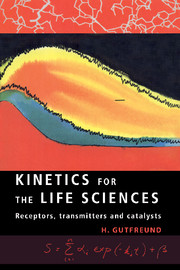Book contents
- Frontmatter
- Contents
- Preface
- 1 The time scales of nature: a historical survey
- 2 Some mathematical introductions
- 3 Elementary kinetic equations: ground rules
- 4 Kinetic analysis of complex reactions
- 5 Transient kinetics of enzyme reactions
- 6 Chemical relaxation phenomena
- 7 Factors affecting rates of reactions
- 8 The role of light in kinetic investigations
- References
- Index
7 - Factors affecting rates of reactions
Published online by Cambridge University Press: 08 January 2010
- Frontmatter
- Contents
- Preface
- 1 The time scales of nature: a historical survey
- 2 Some mathematical introductions
- 3 Elementary kinetic equations: ground rules
- 4 Kinetic analysis of complex reactions
- 5 Transient kinetics of enzyme reactions
- 6 Chemical relaxation phenomena
- 7 Factors affecting rates of reactions
- 8 The role of light in kinetic investigations
- References
- Index
Summary
Concepts and their history
Introduction
In homogeneous systems the major factors which control the rates of reactions are the concentrations, the steric requirements and the energy barriers. The first of these is described by the law of mass action (section 3.1) and the other contributions by the rate constants. In organized systems spatial distributions of the components add to the complexities. In this chapter we are mainly concerned with the chemical dynamics of single reaction steps which determine the individual rate constants, as distinct from the phenomenological description of the time course of a sequence of events; the latter being the main concern of most of the rest of this volume. The frontiers between these two subjects are diffuse and the limits of their semantic distinction are raised in several sections. Another fundamental aspect of rate processes, related to their chemical dynamics, is the thermodynamic description of the extent to which a reaction will proceed (see for instance Edsall & Gutfreund, 1983, for biochemical reactions). As will be seen below, thermodynamic considerations are involved in the description of energy barriers as well as in the description of the final outcome of reactions. Diffusion is an important part of molecular dynamics and different problems arise at different levels of molecular complexity and cellular organization. Spatial and steric problems, including conformational mobility, are of special importance in biological processes which involve the reactions of large and complex molecules.
- Type
- Chapter
- Information
- Kinetics for the Life SciencesReceptors, Transmitters and Catalysts, pp. 231 - 280Publisher: Cambridge University PressPrint publication year: 1995



